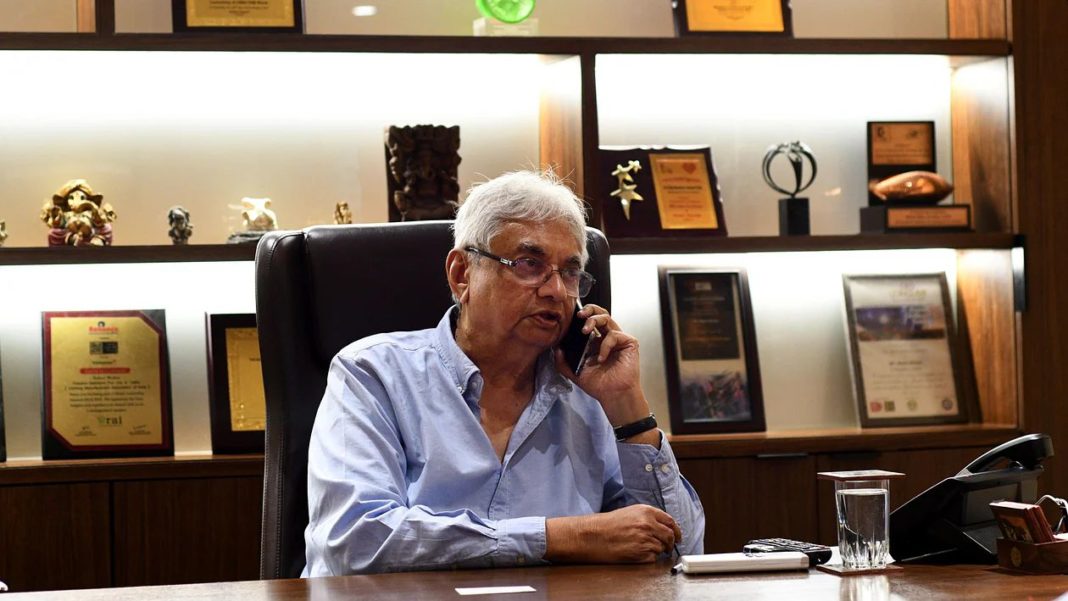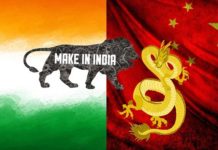https://www.freepressjournal.in/business/indian-apparel-industry-to-grow-10-to-12-pa
Rahul Mehta talks about a strong revival for apparels
 Rahul Mehta has a dynamic and multi-dimensional personality. He was the Past President of the Clothing Manufacturers Association of India (CMAI) and is currently the Chief Mentor of CMAI since 2020. He is also a member of the Executive Committee of the Apparel Export Promotion Council. Today he is acknowledged as one of the leaders of the Domestic Garment Industry.
Rahul Mehta has a dynamic and multi-dimensional personality. He was the Past President of the Clothing Manufacturers Association of India (CMAI) and is currently the Chief Mentor of CMAI since 2020. He is also a member of the Executive Committee of the Apparel Export Promotion Council. Today he is acknowledged as one of the leaders of the Domestic Garment Industry.
He is also the Immediate Past President of the International Apparel Federation (IAF) based out of the Netherlands. The IAF is a Federation of the National Associations of 47 countries including the USA, China, Germany, France, Italy, Bangladesh, Pakistan, Sri Lanka, Korea, Taiwan, etc. He is the first Indian to be elected as President of the IAF, and only the second Asian to be in this position in the 40 years of history of IAF.
In an insightful interaction with Dominic Rebello and RN Bhaskar, both from the Free Press Journal, Mehta discusses the current state of the apparel sector, shares his views on why Bangladesh and China are ahead of India, and how the domestic market of India has helped the industry to survive.
Edited Excerpts:
Your view on the Indian textile and apparels industry
India’s future lies in apparel. Some of the errors that media often makes are to over-emphasize the export segment compared to the domestic segment. The apparel exports of India are to the tune of $15 billion to $16 billion, whereas, the domestic market of apparel is close to $80 billion to $85 billion. Despite the difference in size, the government and the media always talk about just the exports.
The media needs to realise and appreciate that even during the worst world economic crisis, it was the domestic industry of India which helped it to survive, else it would have crashed like many other economies. However, the estimated value may vary, as there is very little authentic data available in the domestic market, unlike exports where every invoice that is sent out has to be recorded in the government’s books. In the domestic market, all data are estimates.
Has any study been done on the domestic apparel sector?
CMAI, that is the Clothing Manufacturers Association of India has for the first time conducted an extremely accurate and professionally researched survey of the Indian market through Nielsen. The research firm was doing its Indian readership survey and we surveyed nearly 80,000 to 85,000 households and collected some very authentic data. The data offers major city-wise, product category-wise, men’s wear women’s wear, kids wear, and within each of these broad segments, shirts, T-shirts, trousers, and so on.
What is the history of this industry?
The birth of the Indian domestic industry began with the tailoring section. People who were tailors with one machine or two machines, then they set up five or 10 machines, and those who were traders too set up some machines. So, traditionally, the Indian domestic industry is hugely fragmented and consists of not just MSMEs but also people belonging to the Micro sector. Today, CMAI has about 4,000 members. Every leading industrial house is our member. We have Arvind, Aditya Birla Group, Raymond’s, Reliance, Shoppers Stop Group, and every major player in the industry as our members. But all these members put together constitute less than 5% of our total membership. 95% of our members have an annual turnover of between Rs 1 crore to Rs 15 crore.
So the domestic industry is fragmented…
The fragmentation in the domestic industry is the strength as well as weakness of the sector. Strength because it gives us the nimbleness, it gives us the flexibility and it gives us the geographical spread. Typically, an industry will have three or four centers where the industry is situated. However, in the case of the garment industry, it is spread all across the country.
The major centers could be Mumbai, Delhi, Ahmedabad, Bangalore, Surat, and Indore, but garment factories are available everywhere.
The other reason for the industry being so fragmented is that the capital investment required to set up a garment factory is minuscule. However, it is the working capital that becomes the obstacle or the speed breaker. What typically happens is that suppose I have a factory of 50 machines, four masters, and three supervisors. One fine day the master will come to me and say I wish to start my own garment factory and he will quit. That’s the way it has been.
So the industry encourages entrepreneurship…
Yes, but what happened is that especially the first generation of entrepreneurs was not educated. They were knowledgeable, they knew how to cut, and they knew how to sew. They had functioning knowledge but no technical knowledge.
Therefore, the level of technological development in the Indian domestic industry has been far slower or weaker than what it should have been or could have been. These are some of the sorts of features or characteristics of the garment industry.
Why has Bangladesh seen such rapid growth, while India with the entire supply chain is lagging behind?
Yes, people often ask this question. The point is, for many years, it was extremely difficult to transport cotton or yarn or fabric from place X to place Y? Today it is extremely simple and extremely cheap. So, today Bangladesh, because of its mastery in sewing, is not finding it a big obstacle in not having a supply chain to back it up, as it was 25 years ago. Today Bangladesh can import whatever it wants from China within seven days. So, what was imagined at one time to be a very big weakness in Bangladesh was not actually there to such an extent.
The other issue and probably far more important is that garment exports from Bangladesh constituted between 85 to 90% of its total exports. So, anything that the garment industry wanted, the government would approve that demand. And so the support for the garment industry was massive in Bangladesh.
In India, the garment industry stood in the queue with 100 other industries with their demands. Here the government’s hands were also tied to some extent in giving that kind of support to the textile or garment industry.
However, Bangladesh’s preferential tariffs as an underdeveloped country could be coming to an end in two years time. That is when India will be more competitive, and Bangladesh less so.
Was the unfairly high import tariff on synthetic also one of the reasons…
Yes, this is valid up to a point. We sort of out-priced ourselves in the world market because of our high cost of inputs. Full marks to the current government as they have tried to address this issue and the direction is very clear.
What is the biggest weakness of the industry?
I think the biggest weakness of our industry is productivity. One of the major reasons is due to historical factors regarding the small sizes of our factories and the other factor is the lack of foresight and vision. Also, probably due to the educational background of the first generation of entrepreneurs, the manufacturers were all very small. So, the introduction of technology was perforce limited. First, it was the inability of the entrepreneurs to understand the advantages of technology and the second factor was the physical limitations. Today, we have machinery which can cut 5,000 pieces a day, whereas typically one master would probably cut 100 to 200 pieces per day. Due to the limited size of the factory, the issue was where would you place that machine and also how to utilize those 5000 pieces a day? So in such a scenario, entrepreneurs will not use the latest technology.
So there was an aversion to making large investments…
There were two big factors for this. One was the government policies that lasted till the late 90s or early 20s of reserving the garment sector in the small-scale sector. That was a major factor as companies were encouraged to remain small. Companies were encouraged to break up their operations into 2, 5, or 10 companies, each situated at different localities. This helped the industry to be covered under the government’s reservation policy. The other reason was the challenging environment as far as the labor practices and the labor laws were concerned. Therefore people did not want to build large factories and get involved in unions.
Many large industries have trade unions and they deal with it. Why was the garment sector trying to avoid it?
At one point in time, I too argued about why can’t we live with trade unions. But there was a very logical explanation given that to most of the other industries, the labour costs would comprise about five to seven to 10% of the total cost. Whereas in the garment industry, it could be as high as 30 to 35%. So that’s where the criticality of labor became much more and therefore the industry did not want to take any chances.
Generally, India had a big disadvantage when it came to capital-intensive industries because of the high cost of capital there was a huge advantage in being labour intensive because it reduced the cost. Your views…
That factor is increasingly diminishing? There are two reasons. One is that the cost of labor is going up and it is a one-way street. India is not going to become poor again. You can argue the toss depending on which side of the political spectrum you are but the fact is that we are still growing at a healthy pace and with that, income levels, especially of the blue-collar and labour are going up. And even more importantly, their aspirations are going up. So today, for example, a person would rather earn that same Rs 15,000 or Rs 20,000 but be in a retail outlet than work in a factory. In the retail outlet, he is well dressed but in a factory, he will be sitting with his shirt open and trying to physically work all the time.
And within the retail outlet, he would rather work under a Shopper Stop or a Pantaloons or a Lifestyle brand rather than Mom and Pop or Multi-brand outlets (MBO) because the respect that you get in society is much more.
I’m involved in a Trust called TRRAIN (Trust for Retailers & Retail Associates of India). We do a lot of things for the retail associates, whom we called salesman in our days. Shopper Stop started an experiment and they call them Customer Care Associates. The attrition fell down and also the demand for employment in Shopper Stop went up. The satisfaction level of the laborers went up for the simple reason that they are now executives, and customer care associates.
So people would rather be in retail stores than within the factories. With that, the wages started going up because the demand for workers far outstripped the supply. So the costs, the criticality of the cost of labor are going up. And with that, the so-called advantage of India being a low-cost producing country is also disappearing, and it is made worse by the other factor which is productivity.

How does China fare?
China is far cheaper than India, and yet their wages are higher than their Indian counterparts. So how do you explain that? Yes, there is government support and everything else is fine. But one of the major factors is the fact that whilst an Indian tailor produces say 10 shirts a day per machine, the Chinese workman produces 15 or 17 shirts. So as far as the cost of labor is concerned, that guy is actually far cheaper. So these are some of the reasons why the Indian industry did not succeed as much as it could have.
How has e-commerce affected the apparel sector?
The kind of churn that is happening in the Indian domestic market is huge. Here there are two aspects that need to be emphasized. Number one, there was a fear at one point in time or even today, about how online e-commerce will destroy offline retail. That is never going to happen. Even in the most developed of countries i.e. the US and the UK, online sales have still not gone beyond 10% to 12%.
Online sales are growing at a much faster pace. It has changed the way consumers make their purchases. And very few brands or companies can today afford to ignore e-commerce.
What are the challenges and potential of the sector?
I personally believe that there is unlimited potential for the domestic industry to grow. The reason is that India’s demographic is changing and the entire population is becoming younger. People in their 20s to 40s today form 60-65% of consumers of garments and readymade clothes. The other reason is the social factors. The semi-rural and rural markets are becoming more and more exposed to international fashion and international trends and therefore, the shift from traditional wear to the so-called modern wear is an unstoppable consequence and that is going to drive the growth of the garment industry.
What is the expected growth for the domestic and export sector?
The domestic sector is likely to grow at 10% to 12% per annum unless COVID-19 strikes again in some different form or in a far more violent form. But those too will only be temporary setbacks in the long run. I believe 10% to 12% growth is a given factor in the garment industry. As far as exports are concerned, it is a little less predictable, because various other international factors also play a role. I personally feel that China is very definitively moving out of the low-skilled segments and China today is about 10 times the size of India. Even a 10% reduction of orders to China and those export orders coming to India, can double our exports.








































COMMENTS